Las Vegas, Nevada (UroToday.com) Dr. Tanya Dorff gave an extensive overview highlighting the major changes and evolving areas in advanced prostate cancer management. Her talk focused on the non-metastatic castrate-resistant prostate cancer (m0CRPC), oligometastatic prostate cancer, and metastatic CRPC (mCRPC).
In the new space of m0CRPC, there has been recent level one evidence coming from three new treatments showing significant overall survival benefit. These include apalutamide (SPARTAN trial1), enzalutamide (PROSPER trial2), and darolutamide (ARAMIS trial3), elegantly summarized in Table 1. However, this space is currently being investigated as new imaging modalities may obliterate this space due to increased specificity and sensitivity for the diagnosis of metastatic disease.
Table 1 – Novel treatment options for non-metastatic castrate-resistant prostate cancer:
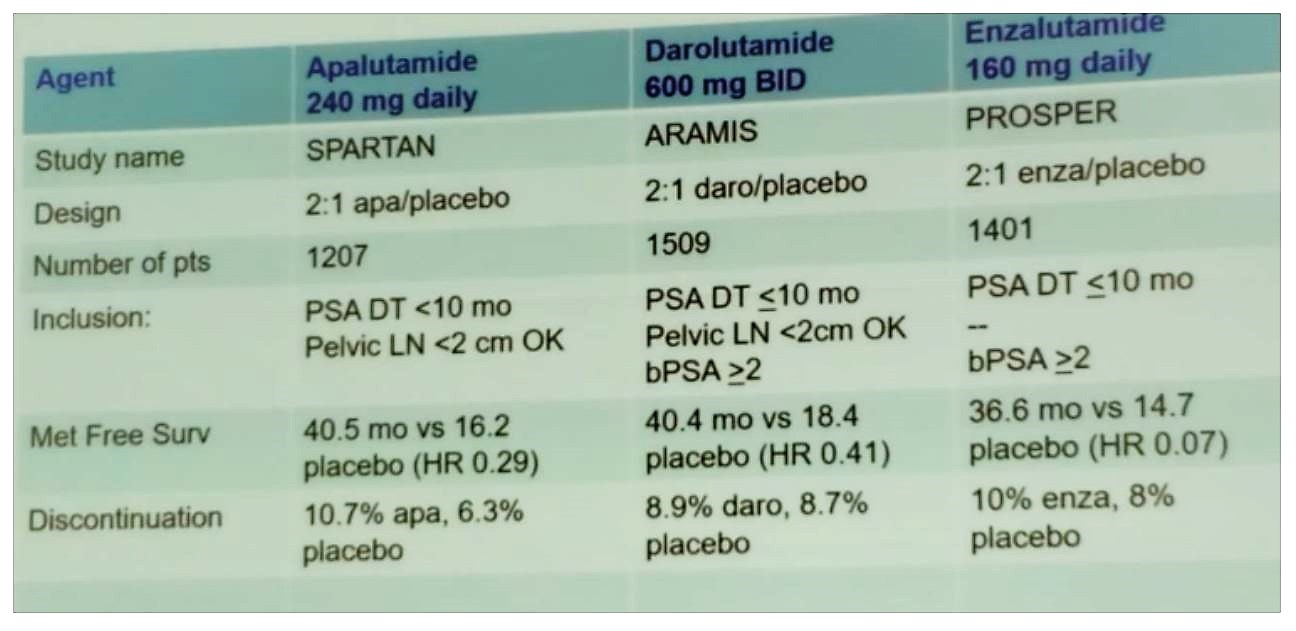
Moving on to metastatic hormone-sensitive prostate cancer (mHSPC), there are still many unanswered questions. Theses include whether the primary tumor needs to be treated in this setting. The STAMPEDE arm H trial4 identified a benefit for radiotherapy to the prostate in patients with low metastatic burden. There is currently an ongoing SWOG 1802 trial (NCT03678025) which randomizes mHSPC patients to standard systemic therapy with or without primary therapy to the prostate in the form of radical prostatectomy or radiotherapy.
Another unanswered issue is the whole concept of metastatic directed therapy (in the form of radiotherapy for example) for oligometastatic disease. It is still not clear if this concept has any benefit, and in what capacity. Lastly, we do not have enough data on whether continuous therapy is still necessary for these patients.
Dr. Dorff moved on to discuss the current treatment paradigm for mCRPC. For this disease space, there have been several treatment options available for some years now. These include:
- Abiraterone, both in the post-chemotherapy5 (overall survival benefit of 14.8 months vs. 10.9 months for placebo) and pre-chemotherapy6 setting (progression-free survival benefit of 16.5 months vs. 8.3 months)
- Cabazitaxel after therapy with docetaxel7 (overall survival benefit of 15.1 months vs. 12.7 months for mitoxantrone)
- Enzalutamide, both in the post-chemotherapy8 (overall survival benefit of 18.4 months vs. placebo 13.6 months) and pre-chemotherapy9 setting (overall survival benefit of 32.4 months vs. 30.2 months for placebo)
- Radium-223 – the ALSYMPCA trial10 showing an overall survival benefit of 14.9 months (placebo 11.3 months)
- Sipuleucel-T – showing and overall survival benefit of 23.2 months vs. 18.9 months for placebo in the IMPACT trial11
- Docetaxel showing an overall survival benefit of 18.9 months vs. 16.5 months in the mitoxantrone group in the landmark trial of TAX 32712
The current treatment paradigm for metastatic prostate cancer is summarized nicely in figure 1. The optimal sequence of treatments is not currently known, but there are several potential recommendations that can be followed (Figure 2). Whatever treatment is given first, there is evidence showing that the second treatment is always less effective, as seen in figure 3.
Figure 1 – The current treatment paradigm for metastatic prostate cancer:
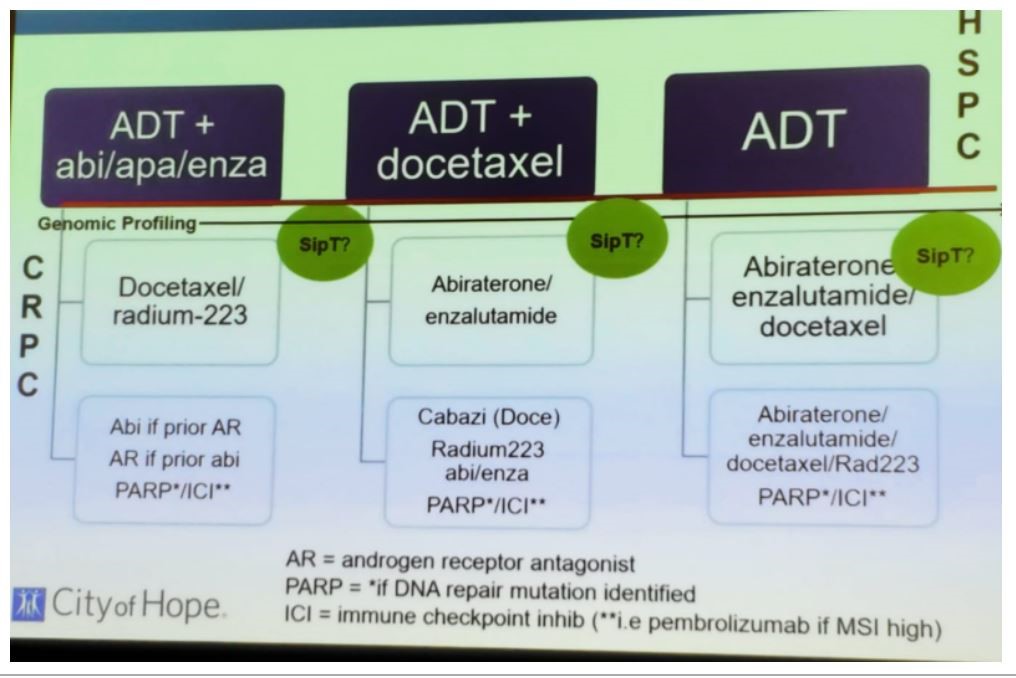
Figure 2 – Treatment sequencing in metastatic prostate cancer – when to consider giving one treatment over the other:
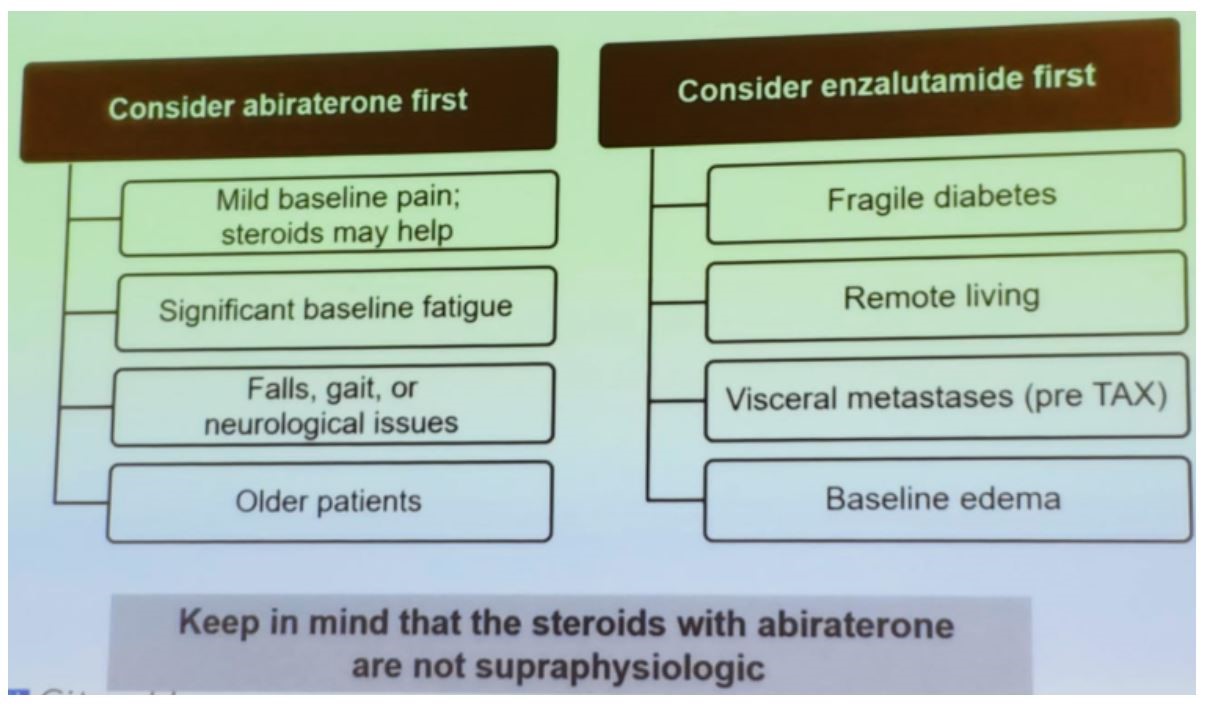
Figure 3 – Treatment sequencing is less effective (abiraterone after enzalutamide or enzalutamide after abiraterone):
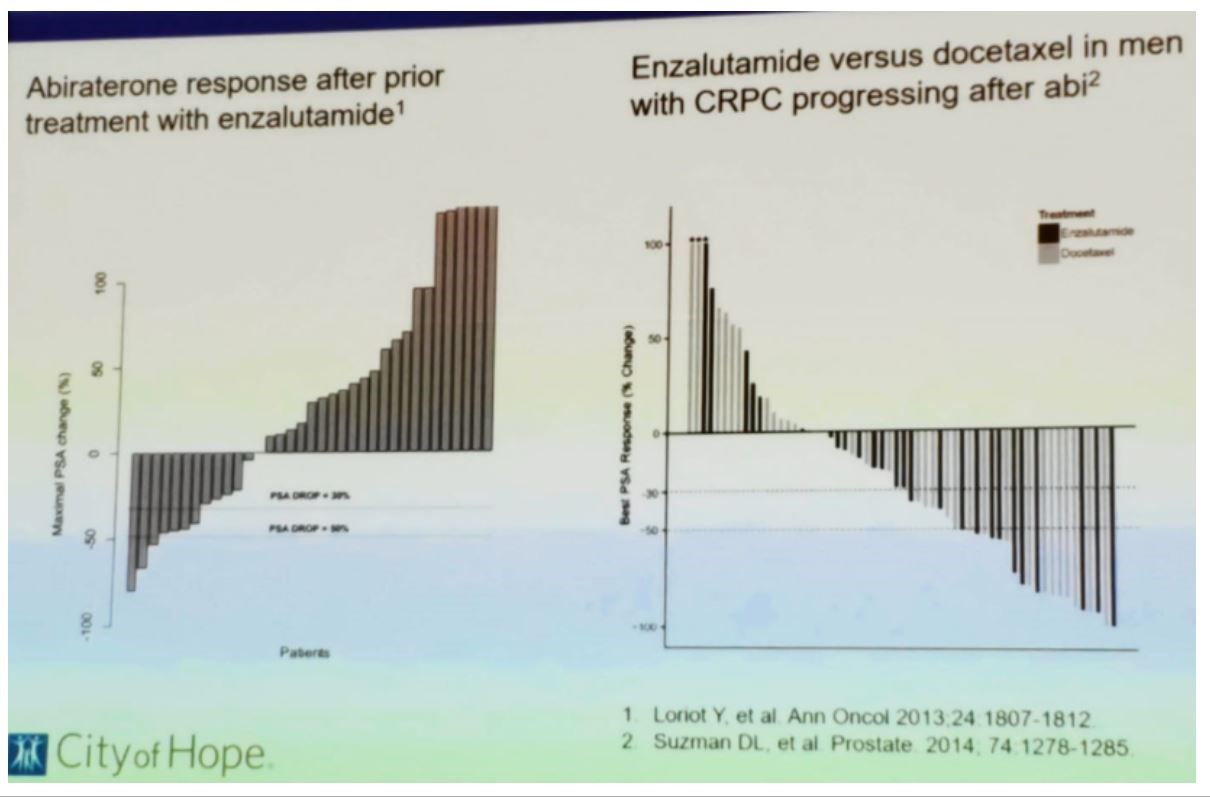
The molecular basis for progression on androgen-signaling targeted inhibitors (abiraterone and enzalutamide) is based on the presence of androgen receptor variant 7 (ARV7) – splice variant without ligand-binding domain. This variant confers resistance to both abiraterone and enzalutamide, but does not confer resistance to docetaxel, and perhaps to radium 223. Another reason for the progression might be treatment-emergent neuroendocrine prostate cancer (t-NEPC) which lacks androgen receptor signaling.
There are also some recommendations to help decide when to treat these metastatic prostate cancer patients with either radium 223 or chemotherapy, shown in figure 4. In general, chemotherapy is preferred when the ARV7 or other molecular markers are present. There is some evidence suggesting that when DNA repair mutations are present, this may predict response to radium-22313, while BRCA mutations may impact response to chemotherapy.14
Figure 4 – How to choose between chemotherapy and radium-223?
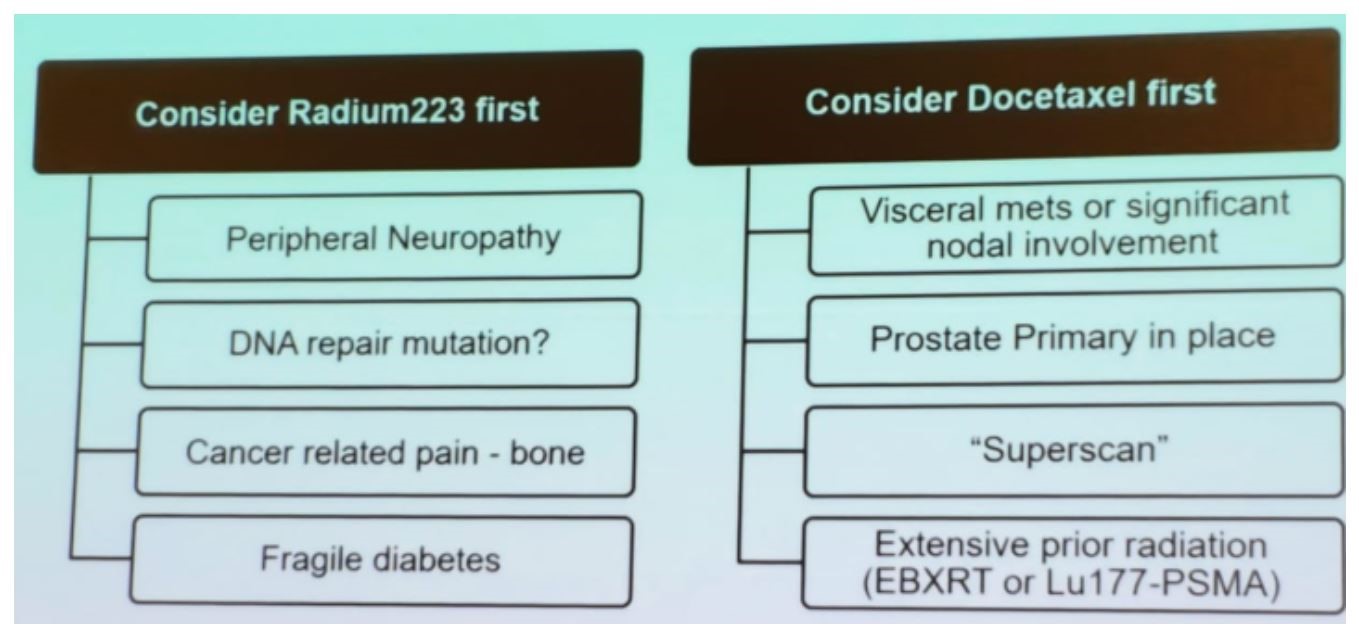
There have been several studies assessing the combination of these treatments. In the A031201 trial, enzalutamide was given with and without abiraterone in patients with mCRPC.15 This study did not show any overall survival difference, but there was a higher rate of grade 3-5 adverse effects in the combination arm.
In the ERA 22316 and PEACE III17 trials, an excess of fractures was noted in the combination of abiraterone or enzalutamide with radium-223. However, adding bone protective agents eliminated the increased fracture risk that was seen in the PEACE III trial. It is unclear yet whether the advantage for abiraterone or enzalutamide with radium-223 exists.
There are still more questions than answers regarding the use of radium-223 (Table 2). It is unclear whether it kills prostate cancer cells, whether it activates the immune system or if it impacts bone health.
Table 2 – What don’t we know yet regarding radium-223?
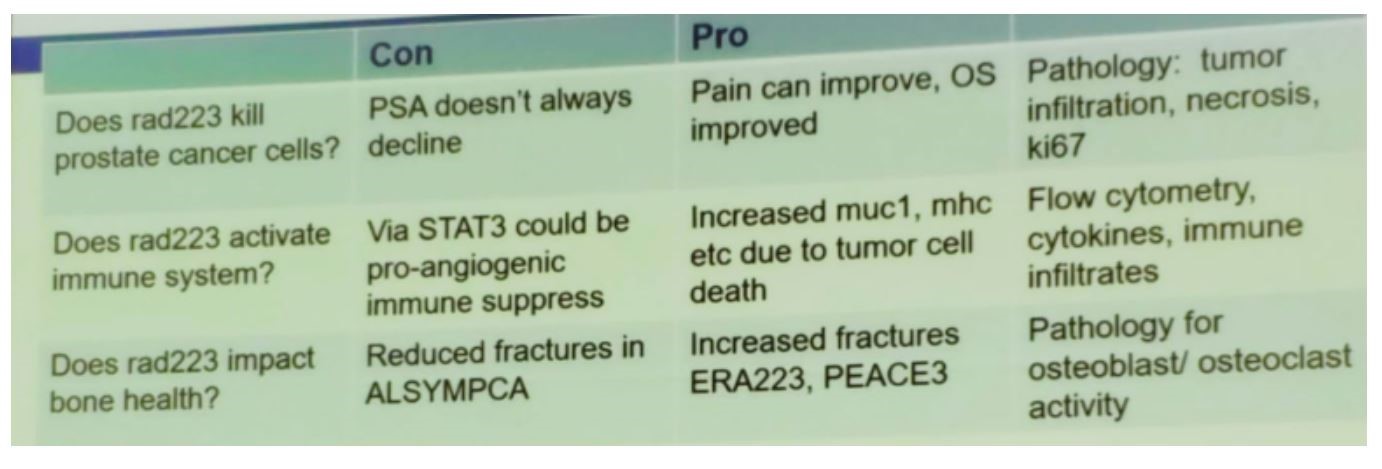
Genomic testing is important and probably recommended in all men with metastatic prostate cancer. This is since a high response rate for the poly ADP ribose polymerase (PARP) inhibitor in men with DNA repair deficiency (BRCA 1 & 2, ATM, Fanconi, and CHEK2) is seen in patients with genomic abnormalities. In the recently presented TOPARP-B trial at ASCO 2019, Olaparib demonstrated antitumor activity against heavily pre-treated mCRPC patients with DNA damage repair (DDR) gene mutations, with BRCA1/2 aberrant tumors being the most sensitive, but with confirmed responses in patients with other DDR alterations.18 Aside from Olaparib, there are currently other agents in the pipeline (niraparib, rucaparib, talazoparib).
The PROFOUND trial is a phase 3 trial that aimed to evaluate Olaparib efficacy and safety versus physician’s choice of either abiraterone acetate or enzalutamide, in patients with mCRPC and a homologous recombination repair gene aberration.19 Initial results were recently presented at the ESMO 2019 meeting (Figure 5) showing a radiologic progression-free survival of 7.39 months in Olaparib treated patients compared to 3.55 months in the patients treated with other therapies.
Figure 5 – PROFOUND trial initial results:
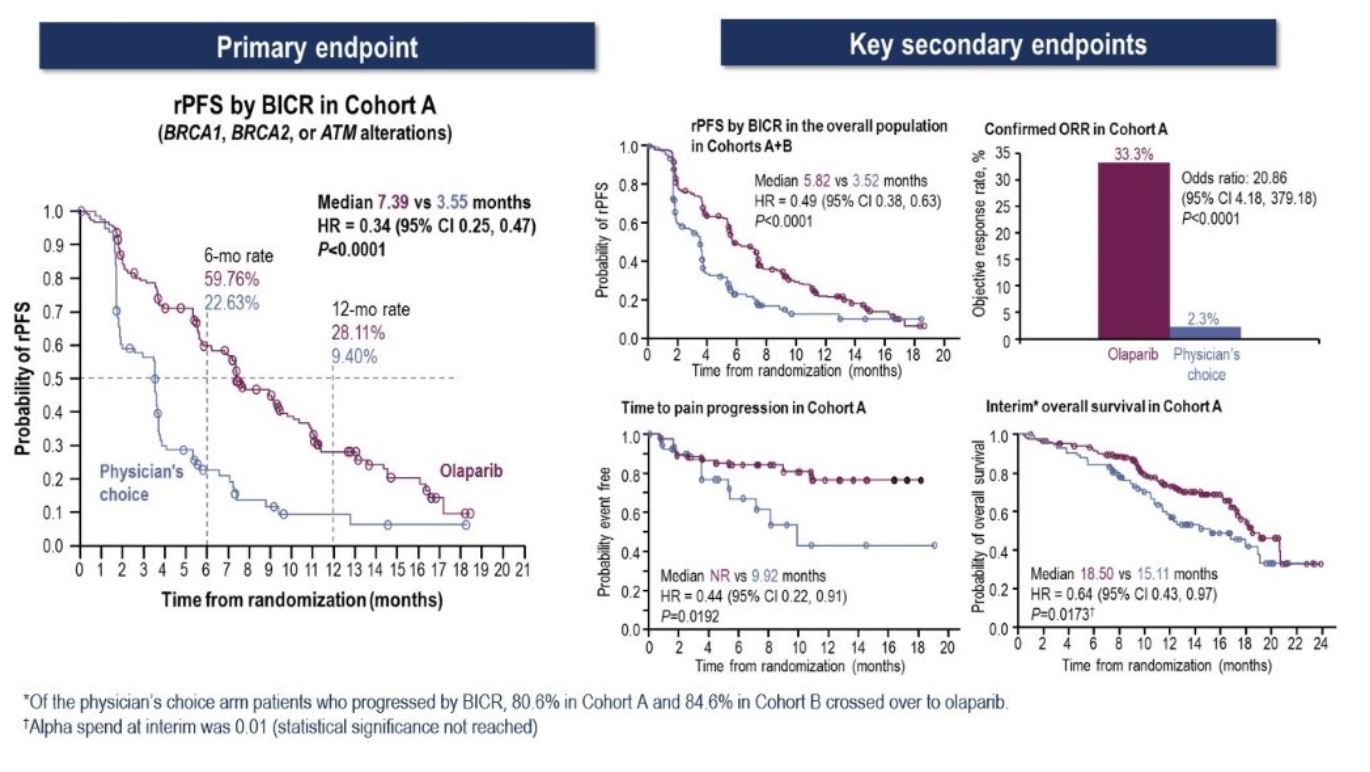
Immunotherapy is also being investigated in the mCRPC setting with the KEYNOTE -199 trial assessing pembrolizumab.20 This had led to the exploration of the idea of combining immunotherapy with radium-223, as can be seen in the trials described in Table 3. Another field that will be deeply explored in the next few years is the field of theranostics, which combines specific targeted therapy based on specific targeted diagnostic tests. The most studied of these compounds is the Lutetium-PSMA. The only ongoing phase three trial assessing this compound is the VISION trial21 (Figure 6).
Table 3 – Trials assessing the combination of Radium-223 + PARP inhibitors with immunotherapy:
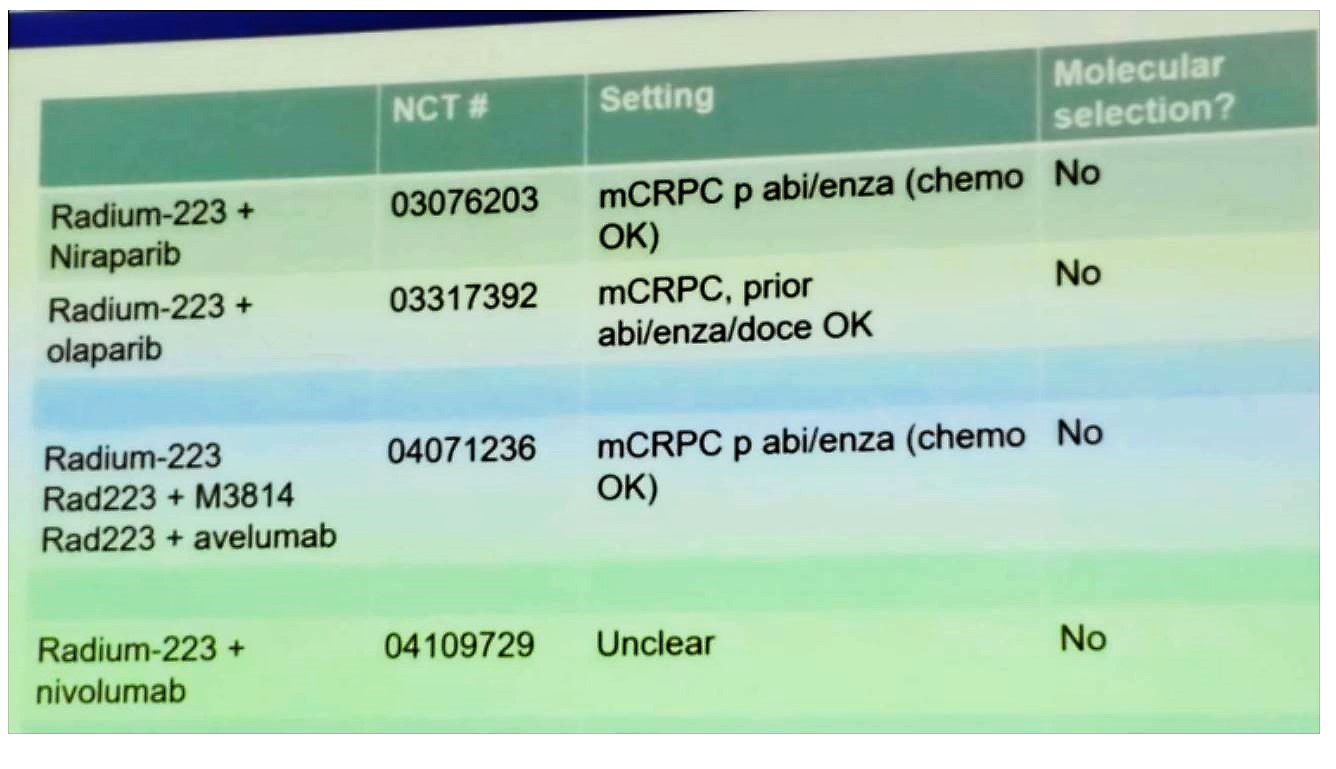
Figure 6 – VISION trial design:
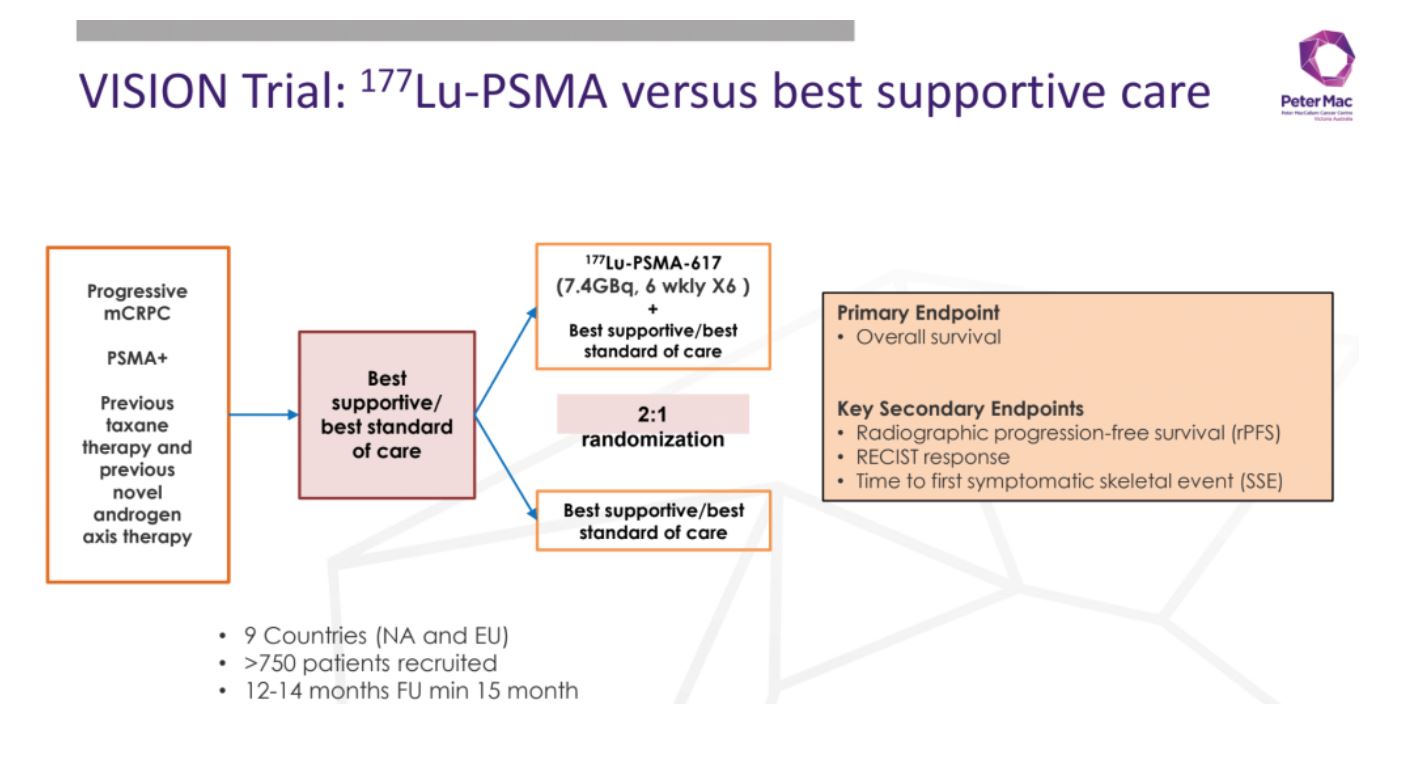
Concluding her talk, Dr. Dorff reiterated that for the m0CRPC space – new advanced imaging may eventually close this space. Combination treatments are not yet helpful, but more studies are needed to explore these combinations. Radio-labeled compounds currently present the next big frontier in the field of metastatic prostate cancer, while immunotherapy is still being explored and optimized.
Presented by: Tanya Dorff, MD, Associate Clinical Professor, Genitourinary Cancer Program Head, Department of Medical Oncology & Therapeutics Research, City of Hope Cancer Center, Duarte, California
1. Smith MR, Saad F, Chowdhury S, et al. Apalutamide Treatment and Metastasis-free Survival in Prostate Cancer. New England Journal of Medicine 2018; 378(15): 1408-18.
2. Hussain M, Fizazi K, Saad F, et al. Enzalutamide in Men with Nonmetastatic, Castration-Resistant Prostate Cancer. New England Journal of Medicine 2018; 378(26): 2465-74.
3. Fizazi K, Shore N, Tammela TL, et al. Darolutamide in Nonmetastatic, Castration-Resistant Prostate Cancer. New England Journal of Medicine 2019; 380(13): 1235-46.
4. Parker CC, James ND, Brawley CD, et al. Radiotherapy to the primary tumour for newly diagnosed, metastatic prostate cancer (STAMPEDE): a randomised controlled phase 3 trial. The Lancet 2018; 392(10162): 2353-66.
5. de Bono JS, Logothetis CJ, Molina A, et al. Abiraterone and Increased Survival in Metastatic Prostate Cancer. New England Journal of Medicine 2011; 364(21): 1995-2005.
6. Ryan CJ, Smith MR, de Bono JS, et al. Abiraterone in Metastatic Prostate Cancer without Previous Chemotherapy. New England Journal of Medicine 2012; 368(2): 138-48.
7. de Bono JS, Oudard S, Ozguroglu M, et al. Prednisone plus cabazitaxel or mitoxantrone for metastatic castration-resistant prostate cancer progressing after docetaxel treatment: a randomised open-label trial. The Lancet 2010; 376(9747): 1147-54.
8. Scher HI, Fizazi K, Saad F, et al. Increased Survival with Enzalutamide in Prostate Cancer after Chemotherapy. New England Journal of Medicine 2012; 367(13): 1187-97.
9. Beer TM, Armstrong AJ, Rathkopf DE, et al. Enzalutamide in Metastatic Prostate Cancer before Chemotherapy. New England Journal of Medicine 2014; 371(5): 424-33.
10. Parker C, Nilsson S, Heinrich D, et al. Alpha Emitter Radium-223 and Survival in Metastatic Prostate Cancer. New England Journal of Medicine 2013; 369(3): 213-23.
11. Kantoff PW, Higano CS, Shore ND, et al. Sipuleucel-T Immunotherapy for Castration-Resistant Prostate Cancer. New England Journal of Medicine 2010; 363(5): 411-22.
12. Tannock IF, de Wit R, Berry WR, et al. Docetaxel plus Prednisone or Mitoxantrone plus Prednisone for Advanced Prostate Cancer. New England Journal of Medicine 2004; 351(15): 1502-12.
13. Isaacsson Velho P, Qazi F, Hassan S, et al. Efficacy of Radium-223 in Bone-metastatic Castration-resistant Prostate Cancer with and Without Homologous Repair Gene Defects. European urology 2019; 76(2): 170-6.
14. Gallagher DJ, Cronin AM, Milowsky MI, et al. Germline BRCA mutation does not prevent response to taxane-based therapy for the treatment of castration-resistant prostate cancer. BJU international 2012; 109(5): 713-9.
15.Morris MJ, Heller G, Bryce AH, et al. Alliance A031201: A phase III trial of enzalutamide (ENZ) versus enzalutamide, abiraterone, and prednisone (ENZ/AAP) for metastatic castration resistant prostate cancer (mCRPC). Journal of Clinical Oncology 2019; 37(15_suppl): 5008-.
16. Smith M, Parker C, Saad F, et al. Addition of radium-223 to abiraterone acetate and prednisone or prednisolone in patients with castration-resistant prostate cancer and bone metastases (ERA 223): a randomised, double-blind, placebo-controlled, phase 3 trial. The Lancet Oncology 2019; 20(3): 408-19.
17. Tombal BF, Loriot Y, Saad F, et al. Decreased fracture rate by mandating bone-protecting agents in the EORTC 1333/PEACE III trial comparing enzalutamide and Ra223 versus enzalutamide alone: An interim safety analysis. Journal of Clinical Oncology 2019; 37(15_suppl): 5007-.
18. Mateo J, Porta N, McGovern UB, et al. TOPARP-B: A phase II randomized trial of the poly(ADP)-ribose polymerase (PARP) inhibitor olaparib for metastatic castration resistant prostate cancers (mCRPC) with DNA damage repair (DDR) alterations. Journal of Clinical Oncology 2019; 37(15_suppl): 5005-.
19. Bono JSD, Hussain M, Thiery-Vuillemin A, et al. PROfound: A randomized Phase III trial evaluating olaparib in patients with metastatic castration-resistant prostate cancer and a deleterious homologous recombination DNA repair aberration. Journal of Clinical Oncology 2017; 35(15_suppl): TPS5091-TPS.
20. Bono JSD, Goh JC, Ojamaa K, et al. KEYNOTE-199: Pembrolizumab (pembro) for docetaxel-refractory metastatic castration-resistant prostate cancer (mCRPC). Journal of Clinical Oncology 2018; 36(15_suppl): 5007-.
21. Sartor AO, Morris MJ, Krause BJ. VISION: An international, prospective, open-label, multicenter, randomized phase 3 study of 177Lu-PSMA-617 in the treatment of patients with progressive PSMA-positive metastatic castration-resistant prostate cancer (mCRPC). Journal of Clinical Oncology 2019; 37(15_suppl): TPS5099-TPS.
